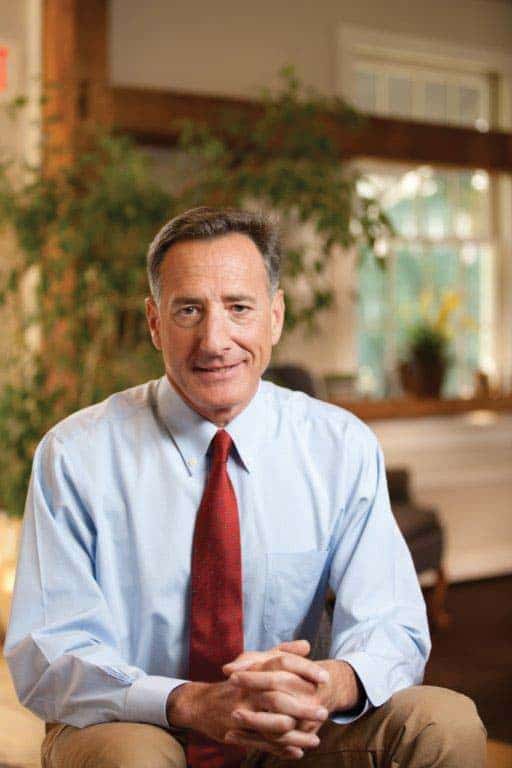By John Flowers
Gov. Peter Shumlin cited adding more jobs, property tax reform and affordable health care as his top priorities for the next biennium should he be elected to a third consecutive two-year term on Nov. 4.
Shumlin, a Putney Democrat, faces opposition from Republican Scott Milne and several independent and third-party candidates. Last week he explained some of the biggest concerns facing the state:
On school governance/consolidation, Shumlin does not support the notion of requiring schools to consolidate. Instead, his strategy during the coming months will be to give communities what he believes are sobering statistics showing that Vermont public schools will need to make some substantial structural changes if they are to remain financially viable. To that end, Vermont Education Secretary Rebecca Holcombe — in partnership with the Vermont School Boards Association — will meet with municipal and school officials to present information and candid feedback.
“We have 30,000 fewer students than we had just a few decades ago and we have a spending problem,” Shumlin said. “But our expenses are higher now…
“I personally have tremendous confidence in the creativity and wisdom of Vermonters, and my feeling is that what no governor has done yet is to give those communities the data they deserve so that they can make good decisions about the future,” he added.
That data, Shumlin said, will show what towns are currently spending and what property taxes are likely to look like in five to 10 years.
“We want to partner (with communities) to help give them the resources to make decisions that will avoid the cost trajectory they are on right now that will kill property taxpayers,” Shumlin said. “I think we need to combine that with incentives that will back up that partnership.”
For example, Shumlin plans to recommend a state Capital Bill this year that will give first priority to communities that are “making infrastructure consolidation decisions and need resources from the state to make (the decisions) work.”
“We are at a point now where we can literally map the state and tell you where we are going to continue to lose students and where we are going to gain,” Shumlin said. “Unfortunately, we are going to continue to lose them in rural communities and see gains in population in the urban communities.”
School financing
Shumlin is aware of the growing hue and cry statewide about the property tax burden that many Vermonters face. But he said the state, at least in the short term, should focus on improving the state’s current education finance law (Act 68), rather than scrapping it for some new hypothetical system.
“I would caution voters to be wary of promises for a new system that no one has a plan for,” Shumlin said, noting the approaching general election. “As frustrated as we are with school spending and property taxes, when you don’t have anyone walking around with a new funding formula that’s better than the one we have, be suspicious of promises of things that don’t exist… I think that if there were a simple solution to this, someone would have figured it out by now,” he added.
Renewable energy
Shumlin is aware of the growing debate surrounding the proliferation of solar and wind projects around the state. Some have complained that these projects are becoming an aesthetic blight on Vermont’s rural landscape. While the governor said he is happy to see that issue debated, he is committed to the state’s transition to green energy.
“What we are doing is not only good for Vermonters’ pocketbooks, it’s good for the planet and the right thing for job creation,” Shumlin said.
Disappointments
Asked to name his biggest disappointments since taking office four years ago, Shumlin cited the failed roll-out of the Vermont Health Connect website. That site — which allows people to register for insurance through a federally mandated health care exchange — has been temporarily deactivated.
He said he is also disappointed that Vermont is part of a “lopsided” economic recovery in which he believes the most affluent residents have been seeing “robust” income growth, the middle class have made little or no gains, and the poorest have seen their resources shrink.
“That is not a sustainable path to prosperity,” Shumlin said.
Economic strengths
One important economic advantage Vermont has, he said, is its unrivaled quality of life — specifically citing the state’s great schools, strong communities and natural beauty.
“Vermont is also leading in a number of emerging economic areas, seizing opportunities to create jobs,” he said. “Vermont is charting a renewable energy future that is attracting entrepreneurs, companies and jobs. In 2013 alone, Vermont created 1,000 solar jobs, the highest growth rate in America.
“When it comes to technology, Vermont is making a big name for itself despite its small size. Burlington, already home to many great technology companies, has been rated one of the top 10 emerging tech hubs in the country. He also said agriculture would continue to be a big part of Vermont’s economic picture, touting Vermont beer, cheese and other value-added products. “The Vermont-made label is sought after and respected worldwide,” he said.
Vermont’s small size is also a big advantage, he said. “Businesses large and small have access to all levels of state government in a way that is unheard of in other states,” he added.
John Flowers is a reporter for the Addison Independent, as sister paper to The Mountain Times.
Shumlin campaign hits high gear




